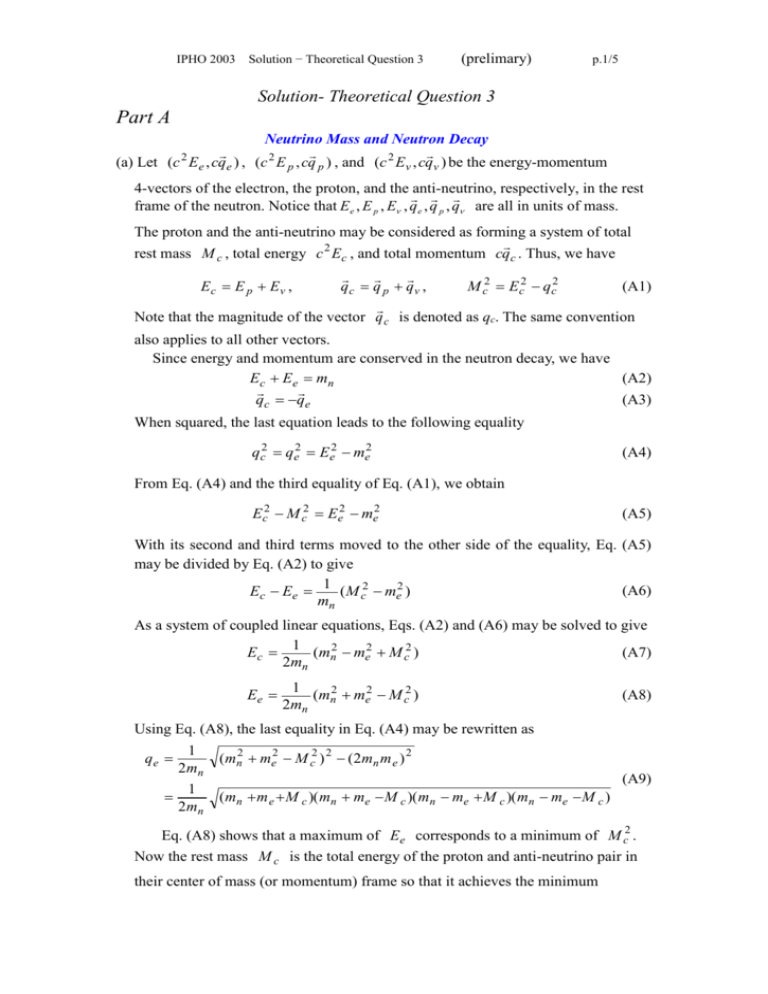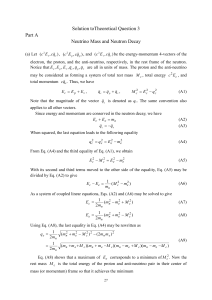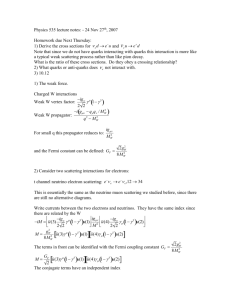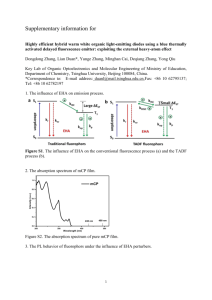Theoretical Question 3 Solution
advertisement

IPHO 2003 Solution − Theoretical Question 3 (prelimary) p.1/5 Solution- Theoretical Question 3 Part A Neutrino Mass and Neutron Decay (a) Let (c 2 Ee , cqe ) , (c 2 E p , cq p ) , and (c 2 Ev , cqv ) be the energy-momentum 4-vectors of the electron, the proton, and the anti-neutrino, respectively, in the rest frame of the neutron. Notice that E e , E p , E , q e , q p , q are all in units of mass. The proton and the anti-neutrino may be considered as forming a system of total rest mass M c , total energy c 2 Ec , and total momentum cqc . Thus, we have Ec E p Ev , qc q p qv , M c2 Ec2 qc2 (A1) Note that the magnitude of the vector q c is denoted as qc. The same convention also applies to all other vectors. Since energy and momentum are conserved in the neutron decay, we have E c E e mn (A2) (A3) qc qe When squared, the last equation leads to the following equality qc2 qe2 Ee2 me2 (A4) From Eq. (A4) and the third equality of Eq. (A1), we obtain Ec2 M c2 Ee2 me2 (A5) With its second and third terms moved to the other side of the equality, Eq. (A5) may be divided by Eq. (A2) to give 1 (A6) Ec Ee ( M c2 me2 ) mn As a system of coupled linear equations, Eqs. (A2) and (A6) may be solved to give 1 (A7) Ec (mn2 me2 M c2 ) 2mn Ee 1 (mn2 me2 M c2 ) 2mn (A8) Using Eq. (A8), the last equality in Eq. (A4) may be rewritten as qe 1 2m n 1 2m n (mn2 me2 M c2 ) 2 (2mn m e ) 2 (A9) (mn m e M c )( mn me M c )( mn me M c )( mn me M c ) Eq. (A8) shows that a maximum of Ee corresponds to a minimum of M c2 . Now the rest mass M c is the total energy of the proton and anti-neutrino pair in their center of mass (or momentum) frame so that it achieves the minimum IPHO 2003 Solution − Theoretical Question 3 (prelimary) M m p mv p.2/5 (A10) when the proton and the anti-neutrino are both at rest in the center of mass frame. Hence, from Eqs. (A8) and (A10), the maximum energy of the electron E = c2Ee is c2 Emax mn2 me2 (m p mv ) 2 1.292569 MeV 1.29 MeV (A11)*1 2mn When Eq. (A10) holds, the proton and the anti-neutrino move with the same velocity vm of the center of mass and we have qp vm q q q (A12) ( v ) | E Emax ( ) | E Emax ( c ) | E Emax ( e ) | M c m p mv c Ev Ep Ec Ec where the last equality follows from Eq. (A3). By Eqs. (A7) and (A9), the last expression in Eq. (A12) may be used to obtain the speed of the anti-neutrino when E = Emax. Thus, with M = mp+mv, we have (mn me M )( mn me M )( mn me M )( mn me M ) vm c mn2 me2 M 2 (A13)* 0.00126538 0.00127 -----------------------------------------------------------------------------------------------------[Alternative Solution] Assume that, in the rest frame of the neutron, the electron comes out with momentum cqe and energy c2Ee, the proton with cq p and c 2 E p , and the anti-neutrino with cqv and c 2 Ev . With the magnitude of vector q denoted by the symbol q, we have E 2p m 2p q 2p , Ev2 mv2 qv2 , Ee2 me2 qe2 (1A) Conservation of energy and momentum in the neutron decay leads to E p Ev mn Ee q p qv qe (2A) (3A) When squared, the last two equations lead to E 2p Ev2 2 E p Ev (mn Ee ) 2 q 2p qv2 2q p qv qe2 Ee2 me2 (4A) (5A) Subtracting Eq. (5A) from Eq. (4A) and making use of Eq. (1A) then gives m 2p mv2 2( E p Ev q p qv ) mn2 me2 2mn Ee (6A) IPHO 2003 Solution − Theoretical Question 3 (prelimary) p.3/5 or, equivalently, 2mn Ee mn2 me2 m 2p mv2 2( E p Ev q p qv ) (7A) If is the angle between q p and q v , we have q p qv q p qv cos q p qv so that Eq. (7A) leads to the relation 2mn Ee mn2 me2 m 2p mv2 2( E p Ev q p qv ) (8A) Note that the equality in Eq. (8A) holds only if = 0, i.e., the energy of the electron c2Ee takes on its maximum value only when the anti-neutrino and the proton move in the same direction. Let the speeds of the proton and the anti-neutrino in the rest frame of the neutron be c p and c v , respectively. We then have q p p E p and qv v Ev . As shown in Fig. A1, we introduce the angle v ( 0 v / 2 ) for the antineutrino by qv mv tan v , Ev mv2 qv2 mv sec v , v qv / Ev sin v (9A) Ev qv Figure A1 v mv Similarly, for the proton, we write, with 0 p / 2 , q p m p tan p , E p m 2p q 2p m p sec p , p q p / E p sin p (10A) Eq. (8A) may then be expressed as 1 sin p sin v 2mn Ee mn2 me2 m 2p mv2 2m p mv ( ) cos p cos v (11A) The factor in parentheses at the end of the last equation may be expressed as 1 sin p sin v cos p cos v 1 sin p sin v cos p cos v cos p cos v 1 1 cos( p v ) cos p cos v 1 1 (12A) and clearly assumes its minimum possible value of 1 when p = v, i.e., when the anti-neutrino and the proton move with the same velocity so that p = v. Thus, it follows from Eq. (11A) that the maximum value of Ee is ( Ee ) max 1 (mn2 me2 m 2p mv2 2m p mv ) 2m n 1 [mn2 me2 (m p mv ) 2 ] 2m n 1 An equation marked with an asterisk contains answer to the problem. (13A)* IPHO 2003 Solution − Theoretical Question 3 (prelimary) p.4/5 and the maximum energy of the electron E = c2Ee is Emax c 2 ( Ee ) max 1.292569 MeV 1.29 MeV (14A)* When the anti-neutrino and the proton move with the same velocity, we have, from Eqs. (9A), (10A), (2A) ,(3A), and (1A), the result qp q p qv Ee2 me2 qv qe v p E p E v E p E v mn E e mn E e (15A) Substituting the result of Eq. (13A) into the last equation, the speed vm of the anti-neutrino when the electron attains its maximum value Emax is, with M = mp+mv, given by ( Ee ) 2max me2 vm ( v ) max Ee c mn ( Ee ) max (mn2 me2 M 2 ) 2 4mn2 me2 2mn2 (mn2 me2 M 2 ) (mn me M )( mn me M )( mn me M )( mn me M ) (16A)* mn2 me2 M 2 0.00126538 0.00127 ------------------------------------------------------------------------------------------------------ Part B Light Levitation (b) Refer to Fig. B1. Refraction of light at the spherical surface obeys Snell’s law and leads to n sin i sin t (B1) Neglecting terms of the order ( /R)3or higher in sine functions, Eq. (B1) becomes n i t (B2) For the triangle FAC in Fig. B1, we have t i n i i (n 1) i (B3) Let f 0 be the frequency of the incident light. If n p is the number of photons incident on the plane surface per unit area per unit time, then the total number of photons incident on the plane surface per unit time is n p 2 . The total power P of photons incident on the plane surface is (n p )( hf 0 ) , 2 with h being Planck’s constant. Hence, P (B4) np 2 hf 0 The number of photons incident on an annular disk of inner radius r and outer radius r +dr on the plane surface per unit time is n p (2rdr ) , where z F t A i n i C Fig. B1 IPHO 2003 Solution − Theoretical Question 3 (prelimary) p.5/5 r R tan i R i . Therefore, n p (2rdr ) n p (2R 2 ) i d i (B5) The z-component of the momentum carried away per unit time by these photons when refracted at the spherical surface is hf o hf 2 (2rdr ) cos n p 0 (2R 2 )(1 ) d c c 2 i i hf (n 1) 2 3 n p 0 (2R 2 )[ i i ] d i c 2 dFz n p (B6) so that the z-component of the total momentum carried away per unit time is hf 0 im (n 1) 2 3 Fz 2R n p ( ) [ i i ] d i c 0 2 hf (n 1) 2 2 2 R 2 n p ( 0 ) im [1 im ] c 4 2 where tan im R Fz (B7) im . Therefore, by the result of Eq. (B5), we have (n 1) 2 2 (n 1) 2 2 R 2 P hf 0 2 P ( ) [ 1 ] [ 1 ] c 2 hf 0 c R 2 4R 2 4R 2 (B8) The force of optical levitation is equal to the sum of the z-components of the forces exerted by the incident and refracted lights on the glass hemisphere and is given by (n 1) 2 2 (n 1) 2 2 P P P P (B9) ( Fz ) [1 ] c c c c 4R 2 4R 2 Equating this to the weight mg of the glass hemisphere, we obtain the minimum laser power required to levitate the hemisphere as P 4mgcR 2 (n 1) 2 2 (B10)*










